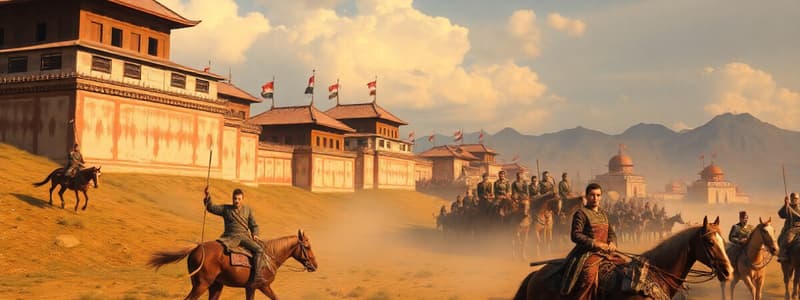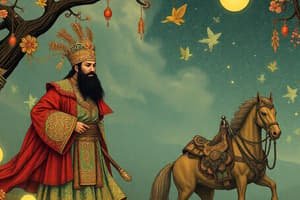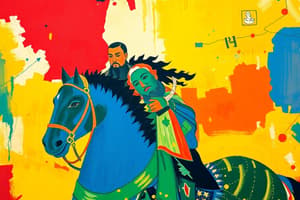Podcast
Questions and Answers
Who was the only woman to assume the title of emperor in China?
Who was the only woman to assume the title of emperor in China?
- Empress Dowager Cixi
- Emperess Wu (correct)
- Empress Shun
- Princess Pingyang
What title was given to Li Shimin after he ascended the throne?
What title was given to Li Shimin after he ascended the throne?
- Li Yuan
- Xuanzong
- Wudi
- Taizong (correct)
Which dynasty's civil service examination system did the Tang rulers revive and expand?
Which dynasty's civil service examination system did the Tang rulers revive and expand?
- Sui Dynasty
- Song Dynasty
- Han Dynasty (correct)
- Qin Dynasty
What was one significant reform made by Tang Taizong regarding the military?
What was one significant reform made by Tang Taizong regarding the military?
What major infrastructure project did the Tang rulers strengthen that started with the Sui Dynasty?
What major infrastructure project did the Tang rulers strengthen that started with the Sui Dynasty?
Which of the following accurately describes the social class of those who usually passed the civil service exams?
Which of the following accurately describes the social class of those who usually passed the civil service exams?
What was a major flaw in the civil service examination system during the Tang Dynasty?
What was a major flaw in the civil service examination system during the Tang Dynasty?
What effect did the Tang rulers' reforms have on the governing class in China?
What effect did the Tang rulers' reforms have on the governing class in China?
What type of living structure did steppe nomads use?
What type of living structure did steppe nomads use?
What was a common reason for clans to unite according to the content?
What was a common reason for clans to unite according to the content?
How did nomads and settled societies primarily interact?
How did nomads and settled societies primarily interact?
What assumption did nomads have regarding their lifestyle?
What assumption did nomads have regarding their lifestyle?
What typically happened to settled peoples during nomadic raids?
What typically happened to settled peoples during nomadic raids?
What could enhance the likelihood of nomadic attacks on settled communities?
What could enhance the likelihood of nomadic attacks on settled communities?
What significant transformation occurred with strong nomadic rulers over time?
What significant transformation occurred with strong nomadic rulers over time?
Who is Temujin, and what was notable about his early life?
Who is Temujin, and what was notable about his early life?
What was one significant effect of improvements in transportation during the Tang and Song dynasties?
What was one significant effect of improvements in transportation during the Tang and Song dynasties?
Which of the following best describes the social classes that emerged during the Tang and Song periods?
Which of the following best describes the social classes that emerged during the Tang and Song periods?
Which emperor is noted for having taken significant steps to restore bureaucratic structure in China?
Which emperor is noted for having taken significant steps to restore bureaucratic structure in China?
What was one of the primary technological advancements attributed to the Tang and Song dynasties?
What was one of the primary technological advancements attributed to the Tang and Song dynasties?
What concept about gaining power was highlighted during the Tang and Song dynasties?
What concept about gaining power was highlighted during the Tang and Song dynasties?
How did the Tang Dynasty benefit from the previous accomplishments of the Sui Dynasty?
How did the Tang Dynasty benefit from the previous accomplishments of the Sui Dynasty?
Which poet's expressions relate to the sentiments and life experiences of the Tang and Song period?
Which poet's expressions relate to the sentiments and life experiences of the Tang and Song period?
What major impact did the Mongols have on the Chinese dynasties mentioned?
What major impact did the Mongols have on the Chinese dynasties mentioned?
What was one of Kublai Khan's notable actions regarding his gardens in Beijing?
What was one of Kublai Khan's notable actions regarding his gardens in Beijing?
During his time with Kublai Khan, what role did Marco Polo primarily serve?
During his time with Kublai Khan, what role did Marco Polo primarily serve?
What event led to Marco Polo's imprisonment?
What event led to Marco Polo's imprisonment?
What aspect of Kublai Khan's personality is highlighted in Polo's description?
What aspect of Kublai Khan's personality is highlighted in Polo's description?
Which of the following languages skills did Marco Polo acquire during his travels?
Which of the following languages skills did Marco Polo acquire during his travels?
What did Marco Polo famously describe about Chinese homes?
What did Marco Polo famously describe about Chinese homes?
What was a significant outcome of Marco Polo's imprisonment?
What was a significant outcome of Marco Polo's imprisonment?
Which of the following best characterizes Polo's identity despite his experiences?
Which of the following best characterizes Polo's identity despite his experiences?
Which geographic feature is most likely located near the Persian region based on the provided map?
Which geographic feature is most likely located near the Persian region based on the provided map?
What could be inferred about the distance between the regions mentioned in the provided content?
What could be inferred about the distance between the regions mentioned in the provided content?
Regarding the geographical positioning, which of the following statements is accurate?
Regarding the geographical positioning, which of the following statements is accurate?
What could the scale measure if one were to interpret the kilometers indicated?
What could the scale measure if one were to interpret the kilometers indicated?
Which area in the content is likely to have the most mountainous terrain?
Which area in the content is likely to have the most mountainous terrain?
Considering the proximity of regions, which option represents a likely relationship based on geographical features?
Considering the proximity of regions, which option represents a likely relationship based on geographical features?
What factor could hinder travel between these regions based on their geographical features?
What factor could hinder travel between these regions based on their geographical features?
Which of the following statements is true regarding the general climate of the areas mentioned?
Which of the following statements is true regarding the general climate of the areas mentioned?
Based on the content, which option likely represents a significant cultural or historical connection between these regions?
Based on the content, which option likely represents a significant cultural or historical connection between these regions?
What was one significant issue that Kublai Khan faced during the latter years of his reign?
What was one significant issue that Kublai Khan faced during the latter years of his reign?
What role did family disagreements play in the decline of the Yuan Dynasty?
What role did family disagreements play in the decline of the Yuan Dynasty?
Which factor did NOT contribute to the rebellions against Mongol rule in the 1300s?
Which factor did NOT contribute to the rebellions against Mongol rule in the 1300s?
What event marked the end of Kublai Khan's influential rule?
What event marked the end of Kublai Khan's influential rule?
How did the Mongol rulers affect the economy of China during their reign?
How did the Mongol rulers affect the economy of China during their reign?
What impact did Kublai Khan's military expeditions have on his empire?
What impact did Kublai Khan's military expeditions have on his empire?
What became a consequence of the growing resentment among the Chinese towards their Mongol rulers?
What became a consequence of the growing resentment among the Chinese towards their Mongol rulers?
Which of the following was NOT a challenge faced by Kublai Khan's successors?
Which of the following was NOT a challenge faced by Kublai Khan's successors?
Flashcards
Empress Wu
Empress Wu
The only woman to become emperor in Chinese history.
Tang Taizong
Tang Taizong
A Tang Dynasty general who restored China's glory.
Taizong's military campaigns
Taizong's military campaigns
Expanded China's borders to Manchuria, Vietnam, and the Aral Sea.
Tang rulers' government reforms
Tang rulers' government reforms
Signup and view all the flashcards
Scholar-officials
Scholar-officials
Signup and view all the flashcards
Civil service examination system
Civil service examination system
Signup and view all the flashcards
Limited access to exams
Limited access to exams
Signup and view all the flashcards
Tang Dynasty's impact
Tang Dynasty's impact
Signup and view all the flashcards
Wu Zhao
Wu Zhao
Signup and view all the flashcards
movable type
movable type
Signup and view all the flashcards
gentry
gentry
Signup and view all the flashcards
Tang Dynasty accomplishments
Tang Dynasty accomplishments
Signup and view all the flashcards
Tang Dynasty bureaucracy
Tang Dynasty bureaucracy
Signup and view all the flashcards
Tang and Song Urban Classes
Tang and Song Urban Classes
Signup and view all the flashcards
Tang and Song transportation improvements
Tang and Song transportation improvements
Signup and view all the flashcards
Steppe Nomads' Diet
Steppe Nomads' Diet
Signup and view all the flashcards
Steppe Nomads' Shelter
Steppe Nomads' Shelter
Signup and view all the flashcards
Steppe Nomad Kinship Groups
Steppe Nomad Kinship Groups
Signup and view all the flashcards
Steppe Nomads and Trade
Steppe Nomads and Trade
Signup and view all the flashcards
Steppe Nomad Raids
Steppe Nomad Raids
Signup and view all the flashcards
Defending Against Nomadic Raids
Defending Against Nomadic Raids
Signup and view all the flashcards
Mongol People's Lifestyle
Mongol People's Lifestyle
Signup and view all the flashcards
Genghis Khan's Legacy
Genghis Khan's Legacy
Signup and view all the flashcards
What was the 'PERSIA' acronym used for?
What was the 'PERSIA' acronym used for?
Signup and view all the flashcards
Where was Arabia located, according to the Map?
Where was Arabia located, according to the Map?
Signup and view all the flashcards
What is the significance of the 'Lhasa' location on the map?
What is the significance of the 'Lhasa' location on the map?
Signup and view all the flashcards
What is the importance of the 'Indian subcontinent' location on the map?
What is the importance of the 'Indian subcontinent' location on the map?
Signup and view all the flashcards
What was the 'Gulf' near Arabia?
What was the 'Gulf' near Arabia?
Signup and view all the flashcards
What geographic feature was represented by the 'Himalayas' in this map?
What geographic feature was represented by the 'Himalayas' in this map?
Signup and view all the flashcards
What was the significance of the '60° E' line on the map?
What was the significance of the '60° E' line on the map?
Signup and view all the flashcards
What are some of the key geographical features highlighted in the map?
What are some of the key geographical features highlighted in the map?
Signup and view all the flashcards
How did geography affect the development of civilizations in this region?
How did geography affect the development of civilizations in this region?
Signup and view all the flashcards
Why is studying historical maps important?
Why is studying historical maps important?
Signup and view all the flashcards
Kublai Khan's Expansions
Kublai Khan's Expansions
Signup and view all the flashcards
Yuan Dynasty Weaknesses
Yuan Dynasty Weaknesses
Signup and view all the flashcards
Rebellions Against Mongols
Rebellions Against Mongols
Signup and view all the flashcards
Yuan Dynasty Decline
Yuan Dynasty Decline
Signup and view all the flashcards
Famine and Disease
Famine and Disease
Signup and view all the flashcards
Economic Problems
Economic Problems
Signup and view all the flashcards
Corruption and Mismanagement
Corruption and Mismanagement
Signup and view all the flashcards
End of Mongol Rule
End of Mongol Rule
Signup and view all the flashcards
Who was Kublai Khan?
Who was Kublai Khan?
Signup and view all the flashcards
How did Kublai Khan treat Marco Polo?
How did Kublai Khan treat Marco Polo?
Signup and view all the flashcards
What did Kublai Khan do to remember his homeland?
What did Kublai Khan do to remember his homeland?
Signup and view all the flashcards
What were Kublai Khan's interests?
What were Kublai Khan's interests?
Signup and view all the flashcards
What was Marco Polo's role at Kublai Khan's court?
What was Marco Polo's role at Kublai Khan's court?
Signup and view all the flashcards
What was Marco Polo's motivation for traveling to China?
What was Marco Polo's motivation for traveling to China?
Signup and view all the flashcards
How did Marco Polo impact European understanding of China?
How did Marco Polo impact European understanding of China?
Signup and view all the flashcards
What happened to Marco Polo after his travels?
What happened to Marco Polo after his travels?
Signup and view all the flashcards
Study Notes
Mongol Conquests
- The Mongols were nomadic pastoralists from the Asian steppe
- They valued horsemanship, discipline, ruthlessness, and courage
- They desired wealth and power, leading to their conquest of vast empires
- The Mongols' empire stretched across much of Asia
- Their empire was the largest land empire in history
- The Mongols were successful conquerors due to their organization and strategic skills
The Mongol Empire
- Genghis Khan united the Mongols, earning the title "universal ruler"
- His successors expanded the empire
- The empire stretched from China to Eastern Europe
- Mongols created four khanates: the Great Khan, Chagatai, Ilkhanate, and Golden Horde
Studying That Suits You
Use AI to generate personalized quizzes and flashcards to suit your learning preferences.




